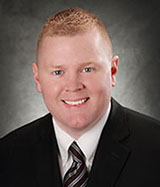YOUNGSTOWN, Ohio – Even with mortgage rates hovering between 7% and 8%, lenders here believe more houses would be sold if more houses were on the market.
The problem bigger than high mortgage rates may be that those who locked in at 2.5% to 4% are loath to sell and buy with a new interest rate that could be double their current one.
“We call it the three D’s – the only time you are selling a house is death, divorce or downsizing,” says Dan Harp, chief lending officer at 717 Credit Union.
The director of mortgage sales at Premier Bank, Tony Lucarelli, says the problem isn’t how high interest rates have risen – they have been much higher – as the speed of that rise.

“Typically, even as rates start to increase, you go off of a low-rate cycle and they start to increase much more gradually than they did this go-round,” Lucarelli says.
To illustrate, Lucarelli says if rates increase by 1% over a year, and a family needs to expand into a larger house, that is not as hard to swallow. “So that rapid increase in rates really caused – the popular term for it is rate lock effect – where people are locked in at a low rate and are reluctant to move out of it.”
Donald Fatobene, senior sales manager at Farmers Bank, says he typically sees buyers move from a starter house to a second house and then a third house. In the ’90s, those moves happened every three years, he says. But today many homeowners are choosing to stay put for now.
LOOKING AHEAD
Will rates start to decrease? The experts are unsure.
While the Federal Reserve Bank has projected several decreases this year, the first, originally anticipated in March, did not happen and now some are talking July.

Should the Federal Reserve drop interest rates this year, which Lucarelli says remains to be seen as drops in inflation have stalled, it will be later in the year before mortgage rates come down. At that point, he sees them closer to 6%.
Harp says he does not believe rates will fall and notes that opinion is backed up by a recent column by Bill Dudley, Bloomberg columnist and former president of the Federal Reserve Bank in New York.
“The mortgage market is run by 10-year treasury notes,” Harp says, “and it’s been getting clobbered ever since this fall … Treasuries are telling us that the economy is not slowing down.”
Harp believes the new rates are part of the new normal and it remains a good time to buy. He also questions why people believe the economy is going to slow down when big businesses continue to invest, when the prime rate is between 6% and 7% and when many people have been making purchases on an 18% credit card.
According to the Fannie Mae Home Purchase Sentiment Index survey released April 8, home buyers and sellers were increasingly pessimistic in March about the direction of mortgage rates, with 34% believing rates will rise over the next 12 months compared to 29% who see them falling. Only 21% believe it is a good time to buy.

Are people waiting for mortgage rates to drop before they buy?
Rich Porrello, director of consumer finance at Huntington Bank, says even if rates do drop as projected in the latter half of the year, he does not believe that is an indicator of what is really happening.
“In our mortgage business, we measure what’s happening with market share and we continue to grow our market share in mortgages,” Porrello says, adding he also sees a “pretty healthy demand” for home equity loans, as well.
Fatobene does not think rates affect buyers as much as the lack of housing. Farmers Bank, he says, sees many people coming in to get prequalified, which means they are looking. But they just are not finding houses.
“The rates do have an effect, but nowhere near [that of] the supply of housing,” Fatobene says, noting either the prices have gone up or the homes are in poorer condition and require renovations. In addition, he says the cost of building new houses becomes a factor, especially for young buyers.

At $200 per square foot to build, trying to find a new 1,500-square-foot ranch house would start at $300,000, by Fatobene’s calculations.
Harp believes the key to building more affordably is to build further away from cities, which has become more popular now that more people work remotely.
For those with younger families, a large portion of the country’s population, many are struggling to get into the housing market. But here it should not be as big of a problem because of prices.
The National Association of Realtors reported that in the fourth quarter of 2023, the median value of houses in both Mahoning and Columbiana counties was just under $151,000, while Trumbull County’s median was under $135,000. In Pennsylvania, Lawrence County was under $137,000 and Mercer County was just above $136,000.
Those numbers are affordable compared to other parts of the country, where median prices begin at $350,000, even $1 million.
“We are fortunate to live in a region where home ownership is affordable,” says Consumers National Bank’s Daniel Eshler, its mortgage division manager. “While local housing prices have increased in the region, the increases were not as severe as those in other areas of the country. Average rental rates also have increased. Therefore, the housing index in the majority of our area is still strong.”

Eshler suggests people talk to their banks about whether renting or buying makes more sense.
Fatobene knows of at least one renovation project where, at completion, the cost of rent will be between $1,200 and $1,400 per month.
But as efforts to attract new jobs and more population to the Valley become successful, a lack of housing may drive up rental prices and the cost of home ownership.
And with higher rent payments, as well as the rising costs of other expenses, some younger families are struggling to enter the housing market.
Eshler cites a variety of programs banks can use to help first-time homebuyers. At Consumers Bank, there are options like the Community Difference loan, which targets those in low- and moderate-income census tracts. And the USDA rural housing loan helps those in designated rural areas.
HOME EQUITY
Although interest rates can be as high as 9%, the rising value of houses is improving the equity of those who already own a home.
While many people are choosing to use their equity for a loan to make improvements, others are using it to pay off higher interest debt, such as credit cards.
Lucarelli knows some lenders, he says, who traditionally focused entirely on mortgages. These lenders have added home equity products to their portfolio over the last 18 months.
Huntington’s Porrello says his bank’s refinancing market has understandably been cut in half from where it was in 2021 and 2022. Should rates come down again, he predicts many people will refinance.
“I think as rates come down, the expectation is there will be more refinance activity,” Lucarelli says, “But it won’t be the customer who had a 3.5% rate looking to refinance. It will be the customer who took out a home equity loan with rates that are 7.5% to 9.5%, depending on which lender you talk to, cashing out to combine those loans together to get out of that higher rate.”
